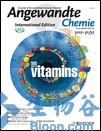Angew Chem Int Ed:抗肿瘤抗生素生物合成研究中发现的一种新奇的自抗性机制
2012-12-26 Angew Chem Int Ed 上海有机化学研究所
结构独特、活性显着的天然产物是大自然进化的结果,而要合成这些高活性化合物同时又要避免其对宿主可能造成的自身伤害是关键前提之一。为此宿主生物进化出多种自抗性保护途径:如外排泵将化合物排出细胞外,对化合物减毒的化学修饰或屏蔽,针对作用靶体的多拷贝、修饰或修复等。最近中国科学院上海有机化学研究所生命有机化学国家重点实验室唐功利课题组在抗肿瘤抗生素谷田霉素的生物合成研究中发现了一类独特的糖基水解酶,其生理
结构独特、活性显着的天然产物是大自然进化的结果,而要合成这些高活性化合物同时又要避免其对宿主可能造成的自身伤害是关键前提之一。为此宿主生物进化出多种自抗性保护途径:如外排泵将化合物排出细胞外,对化合物减毒的化学修饰或屏蔽,针对作用靶体的多拷贝、修饰或修复等。最近中国科学院上海有机化学研究所生命有机化学国家重点实验室唐功利课题组在抗肿瘤抗生素谷田霉素的生物合成研究中发现了一类独特的糖基水解酶,其生理功能是水解被抗生素烷基化修饰的碱基,进而启动碱基剪切修复机制修复因抗生素造成DNA损伤。
谷田霉素(Yatakemycin,YTM)是一类高活性的DNA烷基化试剂(IC50为3 pM),典型的结构特征是吡咯吲哚环上的环丙烷结构。其生物活性源于分子与DNA双螺旋的小沟中畗含AT区域的识别,进而三元环活性中心对腺嘌呤A碱基发生DNA烷基化修饰引起DNA链断裂。
研究表明,该家族化合物不仅可以对游离的DNA双螺旋发生烷基化修饰,还可以高效地对核小体颗粒中的DNA进行烷基化修饰,甚至是几乎全部被组蛋白包围的DNA。因此这类化合物的产生菌如何保护自身的DNA,如何避免烷基化损伤,一直是关注的重点之一。
课题组在克隆YTM基因簇、提出生物合成途径的基础上(J. Am. Chem. Soc., 2012, 134, 8831-8840),通过体内基因敲除、互补、异源表达及体外生化研究,发现了第一例来源于微生物次级代谢的糖基水解酶YtkR2参与的碱基剪切修复机制,其生理功能是参与YTM的自身抗性机制,从而保护产生菌免受YTM这一高活性DNA烷基化剂自身的伤害;与生命有机化学国家重点实验室的王任小课题组合作,通过计算机同源建模的方法模拟了酶(YtkR2)-化合物(YTM)-DNA的三元复合物结构;以此为指导对参与识别的关键氨基酸残基进行了系统突变研究,揭示了参与产物释放的关键疏水空腔对酶功能的影响(Angew. Chem. Int. Ed.2012, 51, 10532-10536)。这一独特机制的发现也引起了同行关注(Nat. Chem. Biol.2012, 8, 873)。
上述研究工作得到国家自然科学基金委、科技部和中国科学院的资助。

DOI: 10.1002/anie.201204109
PMC:
PMID:
Dr. Hui Xu1,‡, Dr. Wei Huang1,‡, Dr. Qing-Li He1, Zhi-Xiong Zhao1, Feng Zhang1, Prof. Dr. Renxiao Wang1, Prof. Dr. Jingwu Kang2, Prof. Dr. Gong-Li Tang1,*
Most of the antibiotics in clinical use to treat human disease are natural products produced by microorganisms. A general hypothesis is that antibiotic-resistance genes and mechanisms have co-evolved with antibiotic biosynthesis as a self-protection scheme.1 Nature has evolved three major ways for avoidance of suicide in antibiotic-producing microbes:2, 3 antibiotic modification, target-protecting enzymes, and export pumps. However, other resistance mechanisms have yet to be discovered, especially for the highly toxic molecules that interrupt basic biological processes (for example DNA, protein, cell-wall biosynthesis).4, 5 DNA-alkylating compounds represent one of the most abundant classes of mutagenic and genotoxic agents present in nature, including several families of DNA-targeting antibiotics for the treatment of cancer.6 Yatakemycin (YTM, 1, Scheme 1) is the most potent member among antitumor antibiotics belonging to the family of CC-1065 and duocarmycins, which are known to be DNA-alkylating agents (IC50 of 3 pM for the L1210 cell line).7 Members of this family have been shown to selectively bind the minor groove of DNA in AT-rich sequences and alkylate adenine at the N3 position. YTM shows the most potent cytotoxicity against cancer cell lines, probably because of its unique “sandwiched” arrangement with a DNA-binding subunit located on each side of the central alkylation subunit; the adenine alkylation depends on both shape-selective recognition and shape-dependent catalysis.8 It has also been reported that YTM selectively alkylates nucleosomal DNA and is almost completely occluded by histones.9 So we have studied how the microorganism that produces YTM protects itself against this highly cytotoxic compound and avoids autotoxicity.
本网站所有内容来源注明为“梅斯医学”或“MedSci原创”的文字、图片和音视频资料,版权均属于梅斯医学所有。非经授权,任何媒体、网站或个人不得转载,授权转载时须注明来源为“梅斯医学”。其它来源的文章系转载文章,或“梅斯号”自媒体发布的文章,仅系出于传递更多信息之目的,本站仅负责审核内容合规,其内容不代表本站立场,本站不负责内容的准确性和版权。如果存在侵权、或不希望被转载的媒体或个人可与我们联系,我们将立即进行删除处理。
在此留言








#抗性#
94
#Angew#
72